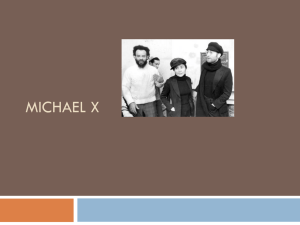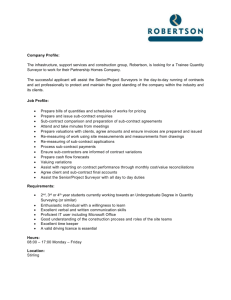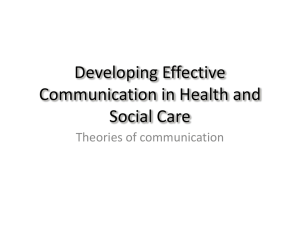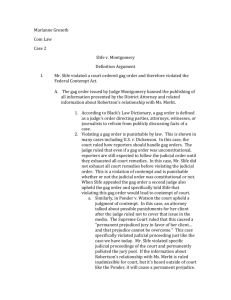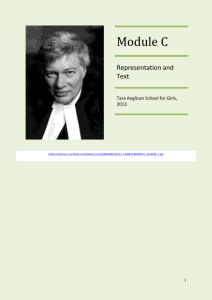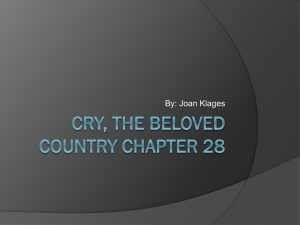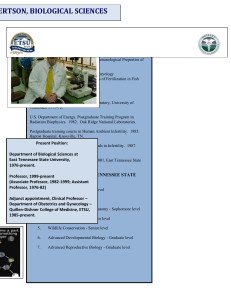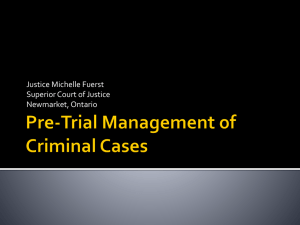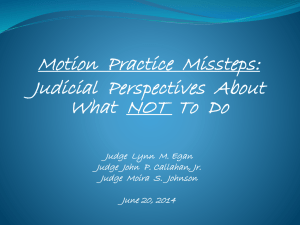The Trials of Oz
advertisement
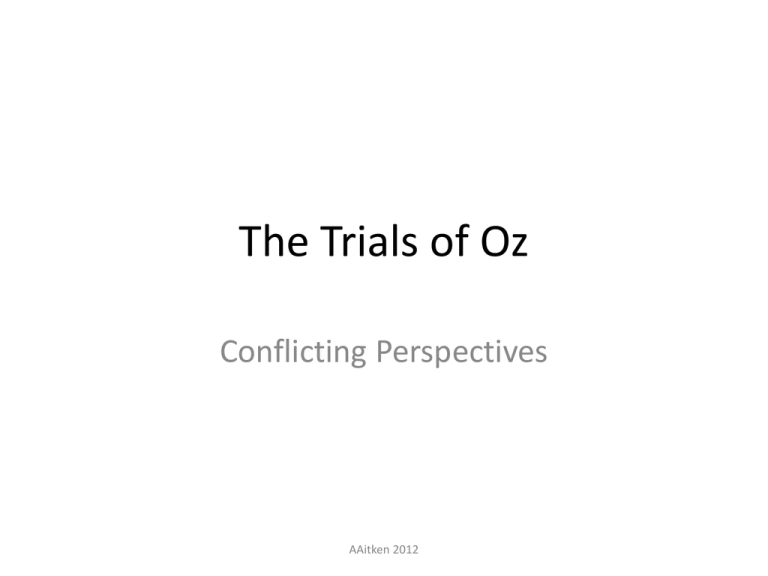
The Trials of Oz Conflicting Perspectives AAitken 2012 Glossary of key terms • • • • • • • • • • • • • • • • • • • Accused Advocacy Advocate Alternative Atavistic Blasphemy Bob Dylan Bulwark Contempt Cunnilingus Defence Delinquent Deportation Depraved Deterrent Dissident Effigy Emancipation Emetic • • • • • • • • • • • • • • • • • • • • Impromptu Indecent Innocuous Inveigh Jurisdiction Juxtaposition Obscenity Ominous Polemic Pornography Prosecution Prurient Quintessential Ritual Sneer Sonorous Squalor Subversion Unedifying Venereal disease Act of Representation • This means that the composer has selected evidence, selectively • It is not a verbatim account of the truth, but a representation of the truth • Robertson is an astute legal man, argument is his “game” • Be aware of how Robertson positions the responder to accept his viewpoint • Be aware of which techniques Robertson uses to represent his version of events. Form • Robertson’s fusion of the personal memoir/nonfiction form is important • Allows him to use his recollections of personal experiences and at the same time, cleverly, appear to be creating a non-fiction (factual) recount. His text is effective in the way it meshes recount and his subjective commentary. • Why is this important? • How does it affect the positioning of the responder? context • 1971 • Robertson early in his career • “I knew all about the law – but nothing about justice, and I was looking forward to seeing it done” • “Schoolkids’ edition” of Oz, a radical, small publication – published pictures of Rupert Bear with an erection • Obscenity trial Opens with Conflicting Perspective • Conservative opinion from treasury counsel, Brian Leary: • “These accused men agreed to publish a magazine which would carry, as it had before, the banner of the alternative society. Look at that magazine and ask yourselves…What alternatives are there? Dropping out of society. Expecting the state to provide – and by the state I mean nothing more than you and me…p 21.” • Look at the tone of this statement. How are we positioned to perceive this conflicting perspective? Cites literary works • Lady Chatterly’s Lover, Last Exit to Brooklyn. • Robertson often cites literary works. • How does this help to position us to receive his views ? He is a learned-man and therefore, reasonable, rational and knowledgeable • How do we perceive him? Inclusion • What is included is an important question for this unit. • Chief Justice conceded that there were some items in the magazine which were “wholly innocuous”, “charming and humourous” • “Statement from the National Union of Teachers, complaining that the magazine would tend to undermine the authority of teachers” p 22 • What is the purpose of including this statement? Does it magnify or minimize the importance of this article? Judge Argyle – conflicting perspective • How is he lampooned? • Inclusion: “famous for his catch-cry ‘we just don’t do this sort of thing in Birmingham” • “Sent delinquents who vandalised public telephone boxes to prison for three years” (Robertson undermines this with reference to the upsurge in telephone vandalism) • “He announced a novel campaign to end burglary by sentencing burglars to prison for life” • What is Robertson’s tone here? • Is it humorous? • How are we positioned to perceive Judge Argyle, before he has even entered the courtroom? Judge Argyle – cont’d • His judgeship was a career consolation for the Tory (Liberal, conservative) MP he had tried to several times to become…” • “Right on!” vs Judge’s interpretation – shows him to be out of touch. He asks, “Write on…but you had finished the interview?” • - Not write on – WRITE on – but RIGHT on… • What is the purpose of including this misunderstanding? De Bono • De Bono’s testimony, about the size and proportions of Rupert Bear’s organs is humorous. • How does this “funny” inclusion work to serve Robertson’s perspective? • Leary, the cross- examining lawyer for the prosecution, asks questions such as “What age do you think Rupert bear is?” – What is the effect of the inclusion of these questions? The Judge • We are positioned to view him as out-dated, an old, conservative man who is out of touch with modern society. • “Well pardon me, (ineffably polite), “For those of us who did not have a classical education, what do you mean by this word “cunnilinctus”? • Mispronunciation of this word included. Why? Robertson represents… • “For Judge Argyle, however, o__l s__ was always unthinkable and invariably dangerous” • Turn to p 28. Read the Judge’s response about “Fatty Arbuckle”. • How does Robertson’s inclusion of this tale and the judge’s erroneous “data bank” help to shape our perception of him? A “telling insight” into Argyle’s mind… • Through Robertson’s narration “He revealed that he had felt it necessary to have a glass of water smashed to pieces, after disc jockey John Peel had taken a sip from it in the witness box. He apparently believed it might be infected because some years before the witness had picked up a brief venereal infection.” Robertson describes this as “bizarre action”. Why “apparently”? Collision of Cultural Incomprehension • “Fancy dress parades”, swords, nosegays. • What is Robertson’s opinion about The Old Bailey? P 31. • How does Robertson lampoon the judge’s over-reactive nature when he includes De Bono’s plan to let a wind up bird fly? P 31. • “The plodding orality of the English courtroom” Description of Defendants • “Yet these defendants were incapable of hurting the proverbial fly…” p 34 Conflicting Perspectives • In America, a Presidential Commission had just reported…that pornography did not cause anti-social behaviour” • Robertson lampoons/mimics the judge “We just don’t need this thing in Birmingham” p 36. Sarcastic tone undermines judge and other conservative viewpoints. Back to the Judge – and his pen… • What is the effect of including the commentary on the judge’s pen movements? • P38. • “Judge Argyle’s view were unconsciously signalled to the jury through tone of voice and body language…” • “he would let it drop – thump – onto the desk, as if it were a thing of infinite toxicity” Leary’s concluding statements • Robertson tells us of Leary’s “effective” closing statements. • Robertson seems to respect Leary’s style, his efficiency as a lawyer • He includes Leary’s statement because it is an example of Leary appealing to middle-class/conservative values (values that conflict with Robertson’s): • “…no doubt your children come from very nice homes where they can discuss properly questions about love and s__ and the dangers of taking drugs…because…morality is essential to the health of a community…and it is for you, ladies and gentlemen of the jury to set the moral standard by which we shall continue to live in this country” Robertson refers to it as a “seductive invitation” John Mortimer - Defence • P 37. Read it. • Mortimer minimizes the Rupert Bear cartoons, saying “Wimbledon tournaments have come and gone…”, whilst we have “turned over, and over, and over again the pages of a little underground magazine” • “A huge quantity of public time and money has been spent in the eager pursuit of what? A schoolboy prank.” • “Cheeky criticism”, “Lavatory humour” • “Adolescent discussion of s__ and drugs” • The deep, sonorous solemnity of a great criminal trial” • Lovely, effective simile “the prosecution is like some nervous public official who, when a child puts out a tongue at him in the street, calls out the army” Juror’s Findings • Jury returns to ask for a definition of “obscene” • “He read to them from the Oxford English Dictionary, which said it meant, among other things, ‘indecent’. In law, that is precisely what obscene does not mean” • Then, after the “guilty” verdicts are read out, we are told that the judge said… “with the relief of a man making a bowel movement after weeks of constipation, “Gaoler, take them down!” • Rhetorical Q – after verdict “where were we – the Soviet Union?” This connotes ideas of strict, totalitarian regimes where freedom and expression are oppressed. Hair Cuts • Robertson positions us: • “the State had wreaked its atavistic (reverting back to a primitive type) revenge by stripping them of their hippie symbol of insolence” • How does this affect the way we perceive the state? Later…p 40 • “At last the forces of reason (therefore, all that has happened up until this point is unreasonable)…began to make themselves heard.” • “Michael Foot, Tony Benn, and many other MPs put down early-day motions condemning the judge for sending them to prison…” and “Bernard Levin…produced for The Times one of his finest polemics against the prosecution.” Psych Report • Which again, conflicts with the Judge’s perspective, but supports Robertson’s: • “They (the defendants) are of high intelligence…polite…courteous. There are aspects of society that appal them and they edited Oz to show the urgent need for reform” (“Judge Argyle, however, was unmoved…” Superb Use of Conflicting Perspectives: • Robertson uses logical arguments in brackets to refute, and therefore disqualify, Judge Argyle’s perspective. P 40. • “As these three accused are over twenty one, probation would be totally inappropriate” (there is no appropriate age for a probation order); “They are comparatively poor men, therefore a fine is inappropriate” (judges should never decide that prison is the only alternative because a person too poor to pay a fine)… • Here, we follow Robertson’s logic – we see his perspective as the “right” one and and the Judge as an incompetent fool. The Irony of it All.. • According to Robertson, the Oz Trial was a “fig leaf” to “cover up the deep and vicious corruption” of the police in London. • He writes the defendants were “Too honest to pay for police protection, too political to be prurient, they were to be the next convenient scapegoats” Robertson and Freedom of Artistic Expression • Robertson sees the Oz trial and “what was practically a replay of the Oz trial in 76”, as being instrumental in ensuring that “the written word, certainly, is now beyond the long arm of the law…” • “We seem to have laughed “lifestyle” prosecutions out of court…” And, finally • Robertson is a liberal minded (not Liberal-minded), progressive QC. • He often sits in opposition to the “status-quo”, those who are on the conservative side of the spectrum, like Argyle and Mary Whitehouse. • He represents his version of the truth, here, as perceived through his particular frame. • His work is an extension of his own public image and a vehicle through which he communicates his values. • We are always aware that he is an intelligent, academic (think of all the literary allusions!) and highly experienced QC, and this knowledge in itself positions us to accept his authority on these matters. Reflection questions (complete after reading the essay) • What charges were laid against the defendants? What could the consequences of these charges be? • What position does the judge take in the trial? How does Robertson portray the judge? Why do you think he does this? • Do you think there should be ‘standards’ in society for publications or do you believe that there should be no censorship. • ‘Truth depends on your perspective’; how true is this statement with reference to this essay. This chapter allows for the examination of the various/conflicting perspectives of truth and censorship. Consider the links on the PowerPoint – Mod C-Related Materials. In particular, focus on the viewing from Media Watch and The Chaser’s War on Everything.
